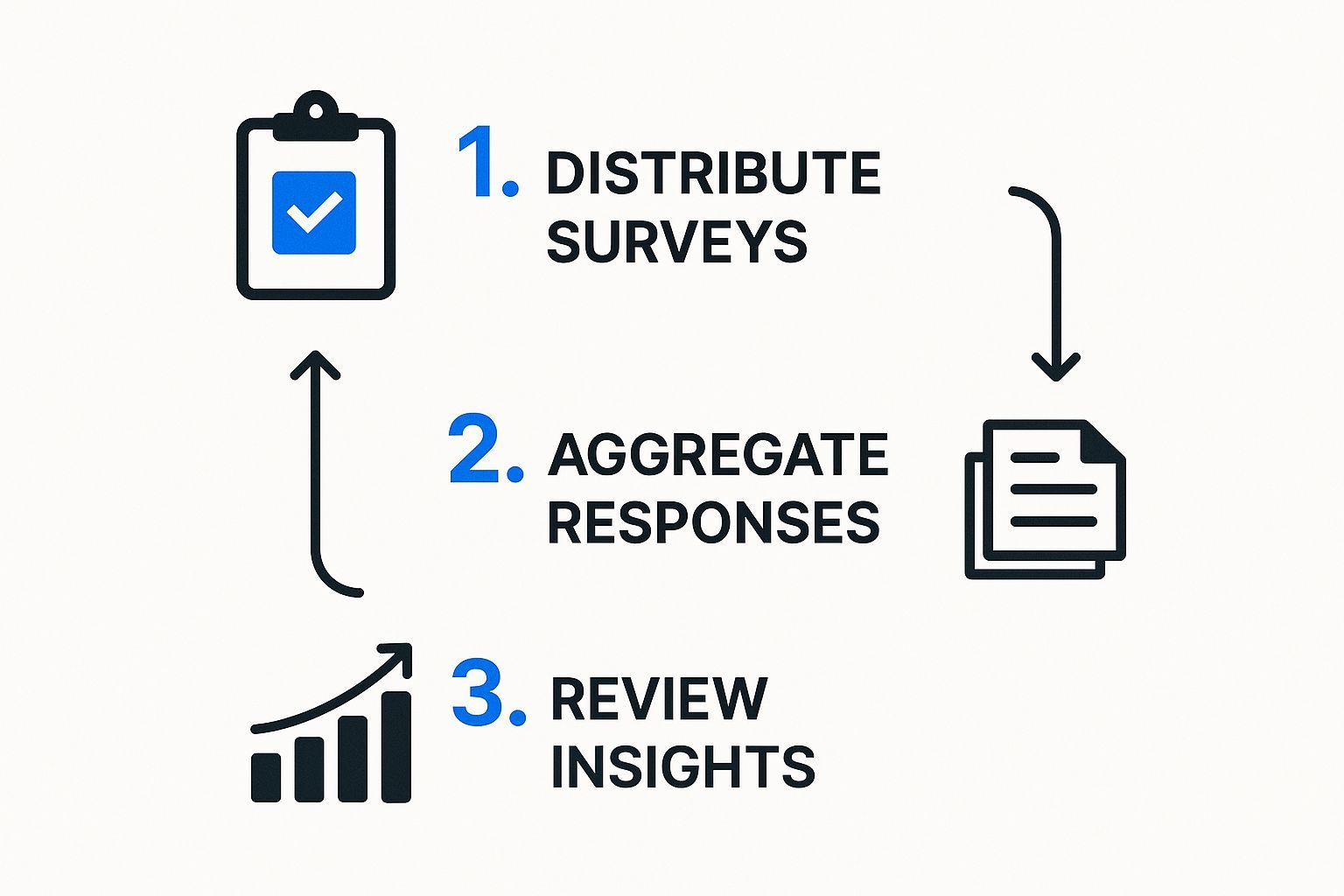
Analyzing Customer Feedback for Business Growth
Discuss with AI
Get instant insights and ask questions about this topic with AI assistants.
💡 Pro tip: All options include context about this blog post. Feel free to modify the prompt to ask more specific questions!
The game of analyzing customer feedback has changed. It's no longer about sending out a yearly survey and waiting for the results to roll in. The real, actionable insights are happening right now, woven into the fabric of every customer interaction. Think less "scheduled check-in" and more "always-on listening."
The most valuable clues aren't in neatly filled-out forms; they’re buried in unsolicited feedback—the raw, unfiltered comments found in support calls, chat logs, and even in how users click around your website.

If your customer listening strategy still revolves around annual surveys and monitoring public reviews, you're likely missing most of the conversation. The way people share their experiences has evolved. Customers aren't just broadcasting their frustrations on social media anymore. Often, their true feelings come out in much subtler, indirect ways.
This means that old-school feedback channels often give you a skewed perspective. They tend to capture the loudest voices—the very happy or the very angry—while the vast, silent majority of your customers' experiences go unheard.
The data backs this up. We're seeing a clear shift away from public complaints. A recent study found that only 16% of consumers now take to social media to report a problem, which is a significant drop of nearly seven percentage points since 2021. In that same vein, just 22% leave reviews on third-party sites, a decline of over four points, according to global consumer trends research from Qualtrics.
People are talking less in public forums, but they haven't stopped giving feedback. They're just giving it differently.
The table below illustrates this changing landscape, showing how the go-to channels for feedback are evolving.
Feedback Channel Recent Trend Implication for Businesses Annual Surveys Declining participation, often biased Captures a snapshot, but misses real-time issues and the "why." Public Reviews (Yelp, G2) Moderate decline in use Still important, but represents only the most motivated customers. Social Media Complaints Significant decline Less a primary complaint channel, more a brand interaction space. Support Tickets/Chats Increasing in value A rich source of direct, problem-oriented, unsolicited feedback. Sales Call Notes Increasing in value Contains candid insights on pricing, features, and competitors. User Behavior Data Rapidly increasing in value Shows what users do, not just what they say. A powerful indirect signal.
This evolution doesn't mean you should abandon your surveys entirely, but it's a clear signal that you need to broaden your listening posts to where the real conversations are happening.
The most potent insights I've seen in my career almost always come from places where we weren't explicitly asking for an opinion. This is the world of unsolicited feedback, and it’s where your customers show you their genuine needs and pain points.
Modern, savvy businesses are striking gold by looking in places others ignore:
- Support Call Transcripts: When you analyze the language and sentiment in service calls, you can spot recurring product bugs or confusing checkout flows that a survey would never flag.
- Live Chat Logs: A chat transcript is a raw, play-by-play of a customer's experience. You see their exact points of friction and their moments of relief in their own words.
- Sales Team Notes: Your sales team's CRM notes are a treasure trove. They often hold the real reasons a prospect chose a competitor or the one feature that sealed the deal.
- User Behavior Analytics: How people navigate your app is a powerful form of feedback. Are dozens of users rage-clicking on an image because they think it's a button? That’s a clear signal to fix your UI.
By tapping into these diverse sources, you stop just hearing the loudest voices. You start listening to the entire chorus of your customer base, uncovering the quiet signals that point directly to hidden growth opportunities.
Let me give you a real-world example. An e-commerce brand I worked with saw its Net Promoter Score (NPS) dip slightly. The survey comments were vague, offering no clear reason. So, we dug deeper.
By analyzing their support ticket data, we found a 30% spike in queries containing the phrase "shipping confirmation." Customers weren't angry enough to write a scathing review, but they were consistently confused and anxious after placing an order.
This was an insight their formal surveys completely missed. Armed with this knowledge, the company redesigned its entire post-purchase email sequence to be clearer and more proactive. The result? A massive drop in related support tickets and a healthy rebound in their customer satisfaction scores the very next quarter.
That’s the power of this approach. It’s about building a complete, authentic picture of the customer journey by listening everywhere, not just where you ask people to speak.
You can't get the whole story by only looking at one piece of the puzzle. If your analysis is limited to survey responses, you're missing out on a treasure trove of honest, unfiltered feedback—the kind customers give when they’re not prompted. To really understand what people are saying, you need to bring all of that scattered feedback into one place.
This means looking beyond the data you ask for and digging into the rich, unstructured conversations happening everywhere else. Think about all the ways a customer "talks" to your company without ever filling out a form.
First things first: map out every single place a customer might interact with your brand. It's easy to overlook some incredibly valuable sources simply because they aren't considered "official" feedback channels.
Your mission is to gather intelligence from places like:
- Support Tickets and Live Chats: These are goldmines. They contain raw, in-the-moment details about product bugs, confusing features, and service hiccups.
- Sales Call Notes: Don't sleep on your CRM data. Sales notes often hold candid feedback on pricing concerns, missing features, and exactly why a promising lead went with a competitor instead.
- Social Media Comments and DMs: This is where you find the really unfiltered opinions. People are brutally honest in Instagram comments and direct messages on platforms like WhatsApp. For tips on managing these conversations at scale, check out this guide on WhatsApp marketing automation for business growth.
- Third-Party Review Sites: What people say on sites like G2, Capterra, or Yelp directly impacts your reputation and can sway potential customers one way or the other.
The big idea here is to break down the silos. When you unify these scattered conversations into a single source of truth, you stop valuable insights from getting lost between departments.
This is more than just collecting data; it's about creating a centralized hub where all feedback lives. The visual below shows how this works in practice—collecting from various sources before you can even think about finding the insights.

As you can see, sending out surveys is just one small part of the process. The real work begins when you aggregate all that feedback—from surveys, support, social media, and more—into one system for analysis.
Once you know where the feedback is, the next challenge is getting it all into one place. This whole concept is the foundation of a formal Voice of the Customer (VoC) program. A VoC program is all about systematically gathering, analyzing, and sharing customer feedback to get a 360-degree view of their experience.
A good VoC program has two sides to it. It’s partly reactive, like jumping on a support ticket to solve a specific person's problem. But it's also proactive, using that collective feedback to spot trends and drive real improvements, whether that's fixing a buggy feature or rethinking your entire onboarding process.
For a small team just starting out, a well-organized spreadsheet might do the trick. But as you grow, you'll quickly find that manual copy-pasting isn't sustainable. That's when dedicated feedback management tools become a lifesaver, automatically pulling in data from all your different channels and saving you countless hours of tedious work.

So, you've gathered a ton of customer feedback from all over the place. That's a great start, but the real magic happens when you turn that raw data into a clear roadmap for what to do next. This is where your analysis toolkit comes in.
Your choice of tools can be as simple as a spreadsheet or as sophisticated as an AI platform. Honestly, the "best" option really boils down to your team's size, budget, and the sheer volume of feedback you're dealing with.
If you’re a smaller business just dipping your toes into analyzing customer feedback, you'd be surprised how far a manual approach can take you. A shared spreadsheet in Google Sheets or a base in Airtable works perfectly for logging feedback as it arrives. I’ve seen teams get great results by creating columns for the source, date, and customer type, then manually tagging each entry with themes like "pricing issue" or "positive support experience."
This hands-on method forces you to really engage with what your customers are saying. It takes discipline, sure, but it costs next to nothing and builds a solid foundation of understanding.
As your company grows, that manual spreadsheet will start to feel less like a tool and more like a burden. The flood of comments becomes overwhelming, and it's all too easy for critical insights to get buried. That’s your cue to start looking at specialized tools designed to do the heavy lifting for you.
When you begin your search, you'll find a wide range of options out there. The key is to match the tool’s features to your actual needs. There's no sense in paying for a massive enterprise platform if a more focused solution gives you everything you require.
The goal isn't just to collect data, but to transform it into strategic intelligence. The right tool should clarify insights, not just create more noise. It should help you see the forest for the trees, revealing the most pressing issues and biggest opportunities hidden in your feedback.
When you're comparing platforms, look for features that go beyond just counting keywords. Modern tools offer capabilities that can seriously deepen your understanding of what customers are trying to tell you.
- Automated Tagging and Categorization: Instead of you manually sorting every comment, the system automatically classifies feedback into themes you’ve defined. This alone can save hundreds of hours.
- Sentiment Analysis: This feature gauges the emotion behind the words—positive, negative, or neutral. It’s fantastic for spotting urgent problems at a glance and tracking overall customer happiness over time.
- Topic and Trend Detection: The really smart platforms can spot new topics and trends you weren't even looking for. Imagine it flagging a sudden spike in mentions of a new competitor, giving you an early heads-up on a market shift.
These features are typically powered by Natural Language Processing (NLP), a type of AI that’s trained to understand human language. As you explore your options, it’s worth reading up on advanced sentiment analysis tools that use NLP and machine learning. Picking a tool with this kind of intelligence means your analysis can grow with your business, continuously feeding you the insights you need to make real improvements.
https://www.youtube.com/embed/YE1HBEY2upg
It's tempting to look at customer feedback analysis as just another expense on the budget—a "cost center." I've seen many companies fall into this trap. But this view is dangerously short-sighted. The real cost isn't in listening to your customers; it's in the deafening silence of not listening.
Think of it this way: your customer base is a bucket you're working hard to fill through marketing and sales. Every unresolved complaint, every frustrating experience, is a hole in that bucket. You can keep pouring in new leads, but you’ll never get ahead until you start plugging those leaks. Ignoring feedback doesn't make the problems disappear; it just hides the cost until it hits your revenue.
When customers have a bad experience, the financial fallout is direct and often severe. They don't just get frustrated and then forget about it. They leave. This churn creates a constant drain on your resources, forcing you to spend far more to replace the customers you couldn't keep.
The data on this is startling. A massive 89% of e-commerce consumers have stopped buying from a brand after a single poor service interaction. This stings even more when you realize that acquiring a new customer costs six to seven times more than retaining an existing one. You can read more about the impact of customer experience over at Invesp.
That's the leaky bucket in action. You're pouring money into acquisition while your existing customers are slipping away through preventable cracks. A solid feedback loop would have caught and fixed those issues long before they became reasons to leave.
A proactive approach to analyzing customer feedback isn't just about making people happy. It’s a direct investment in your bottom line, reducing churn and maximizing the lifetime value of every customer you earn.
If you really want to make the case for investing in a Voice of the Customer (VoC) program, you have to tie it back to the numbers your CFO cares about. Your feedback analysis should directly inform key performance indicators (KPIs) like Customer Lifetime Value (CLV) and Customer Acquisition Cost (CAC).
Here’s how it works. When you use feedback to solve problems, you boost satisfaction and loyalty. Loyal customers don't just stick around; they buy more, they cost less to serve, and they become advocates for your brand. All of that directly drives up your CLV.
At the same time, by plugging those leaks and lowering churn, you reduce your dependency on expensive marketing campaigns to constantly refill the pipeline. This brings down your CAC. Efficient systems are the key to making this happen, and understanding examples of business process automation can reveal how to amplify these financial benefits.
Ultimately, you need to shift your perspective. Stop seeing feedback as a chore and start seeing it as an investment in retention. It's one of the most powerful strategies you have for building sustainable, profitable growth.

Let’s be honest. Just analyzing customer feedback isn’t enough. Without a solid plan to put what you've learned into practice, all that data is just an expensive, time-consuming hobby. The real magic happens when you turn those hard-won insights into tangible improvements that your customers can actually see and feel.
This is where so many companies stumble. A detailed report gets created, it’s briefly discussed in a meeting, and then it’s left to collect digital dust in a shared drive. To make sure your efforts count, you need a system for deciding what to tackle first and getting the right information to the people who can actually do something about it.
First things first, you have to get the insights to the right teams. A flood of feedback about a clunky checkout process is irrelevant to the social media team, but it’s pure gold for your product and dev crews. Your job is to build a reliable pipeline that channels specific types of feedback to their rightful owners.
For example, a string of complaints about slow customer service response times should immediately land on the desk of the Head of Support. On the flip side, a wave of glowing reviews about a new feature could be the perfect inspiration for the marketing team's next campaign. To get this right, you really need a handle on mastering customer experience analytics, as it forms the bedrock of this entire process.
The motivation to act on this data is huge, especially when you look at the numbers. In the United States alone, poor customer service costs businesses a staggering $75 billion every single year. That figure should be a wake-up call, showing the very real economic hit you take when you ignore what customers are telling you.
An insight is only as valuable as the action it inspires. The goal is to build a culture where customer feedback fuels a cycle of continuous improvement across the entire organization.
You can't fix everything at once—and you shouldn't try. The key is smart prioritization. I’ve always found that a simple Impact vs. Effort matrix is one of the most powerful tools for this. It gives you a clear visual map of which actions will give you the most bang for your buck.
- High Impact, Low Effort (Quick Wins): Jump on these immediately. We're talking about things like fixing a broken link in a welcome email or rewriting a confusing sentence on your pricing page.
- High Impact, High Effort (Major Projects): These are your big, strategic moves. Think about a complete overhaul of your user onboarding flow or developing a highly requested integration. These require serious planning and resources.
- Low Impact, Low Effort (Fill-ins): These are nice-to-haves. Squeeze them in when your team has a bit of downtime between bigger projects.
- Low Impact, High Effort (Reconsider): Honestly, just avoid these. The return on investment is almost never worth the time and effort.
This last step is the one most people forget, but it might be the most important: closing the loop. When you make a change based on customer feedback, reach out and tell the people who suggested it.
This simple act of communication does more than just inform; it shows you’re not just collecting data in a vacuum. It proves you’re listening and that you genuinely care. It’s an incredibly powerful way to build loyalty and turn casual customers into passionate advocates. It also encourages them to give you even better feedback next time.
Remember, gathering feedback isn't a one-and-done project. For more great ideas on keeping the conversation going, check out these 10 proven ways to collect customer feedback in 2025.
Even with a solid plan, jumping into customer feedback analysis can feel a little overwhelming. Let's walk through some of the common questions I hear from teams just getting started, so you can feel confident building and improving your own program.
When that harsh review comes in, the gut reaction might be to get defensive. Don't. Your first move should always be to act fast and with real empathy.
Start by simply thanking the customer for their time. It sounds small, but acknowledging their effort to share—even if it was a rant—shows you're listening and immediately de-escalates the situation. Then, get to the bottom of it. Is this a one-off fluke, or are they pointing out a flaw that’s affecting others?
Offer a solution if you can, but the real magic happens when you close the loop. If you end up making a bigger change because of their input, circle back and let them know.
That simple follow-up is incredibly powerful. It can turn an angry customer into one of your biggest fans because you didn’t just listen—you actually did something about it.
You absolutely do not need a massive budget to do this well. Honestly, the most important thing is building the right habits, not buying fancy software. A well-organized spreadsheet is more than enough to get started.
I always recommend teams begin with something simple like Google Sheets or Airtable. Create one central place where you log every piece of feedback you get, whether it's from an email, a social media comment, or a support ticket.
Then, create a basic tagging system. Just a few categories like ‘bug report,’ ‘pricing concern,’ or ‘feature idea’ will do. It's a manual process, for sure, but setting aside time each week to review this log will uncover surprising patterns and give you the data you need to make smart decisions.
This is the big one. To show the value of your feedback program, you have to connect your work to the numbers the business really cares about. It's not enough to say, "We're listening better." You have to prove how that listening is impacting the bottom line.
Before you roll out changes based on feedback, get a baseline for your key metrics. Then, track them afterward to show the impact. Look at things like:
- Customer Retention Rate: Are fewer customers leaving?
- Net Promoter Score (NPS): Is the willingness to recommend you going up?
- Customer Satisfaction (CSAT): Are direct satisfaction scores improving?
- Customer Lifetime Value (CLV): Is the average customer becoming more valuable over time?
Don't forget to watch your operational numbers, too. For example, if you fix a confusing part of your product and see a drop in related support tickets, that's a clear win. Tying your Voice of the Customer (VoC) efforts to these hard numbers makes it easy to show anyone in the company that this work is paying for itself.
Ready to stop guessing and start understanding what your customers truly want? With Spur, you can unify feedback from every channel, use AI to spot trends, and turn insights into action automatically. Our platform helps you resolve issues faster, boost satisfaction, and drive growth. Start your free 7-day trial today.
